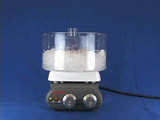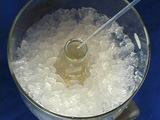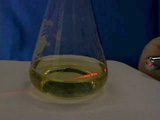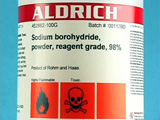
Sodium Borohydride Synthesis of Silver Nanoparticles
The synthesis procedure shown here was adapted by Steve Ng and Chris Johnson from a procedure developed by S.D. Solomon, M. Bahadory, A.V. Jeyarajasingam, S.A. Rutkowsky, C. Boritz, and L. Mulfinger, Journal of Chemical Education, 84, 322-325, (2007).
Ag+ + BH4- + 3 H2O → Ag0 + B(OH)3+ 3½ H2
The formation of silver nanoparticles can be observed by a change in color since small nanoparticles of silver are yellow. A layer of absorbed borohydride anions on the surface of the nanoparticles keep the nanoparticles separated.
| Procedure | Wear eye protection |
 Never look directly into a laser or shine a laser at another person. |
Add 20 mL of 0.003M sodium borohydride (NaBH4) to an Erlenmeyer flask. Add a magnetic stir bar and place the flask in an ice bath on a stir plate. Stir and cool the liquid for about 15 minutes while you work on another experiment. Drip 2 mL of 0.001M silver nitrate (AgNO3) into the stirring NaBH4 solution at approximately 1 drop per second. Stop stirring as soon as all of the AgNO3 is added. Data
The presence of metal nanoparticles can be detected by their interaction with a beam of light since the oscillating electric field causes quantized light emission from the particles. Can you see a laser beam as it passes through the solution? The light from a laser pointer may be polarized with the electric field oscillation in only in one plane. Is your laser pointer polarized? If so the plasmon emission would occur only in one plane. Shine the laser through the solution and rotate the laser. What fraction of a full rotation separates the maximum and minimum observed brightness in the solution?
Record the visible spectrum of the solution. You will need data from 375 nm and longer wavelengths. What is the peak wavelength? What is the peak width at half the maximum height? You may need to measure the width of the longer wavelength half and then double the value to get the full width.
- Stock Solutions for 8 batches
- 0.001M AgNO3: Dissolve 0.017 g of AgNO3 into 100 mL distilled water. This solution should be stored in the dark and can be kept for later usage.
- 0.003M NaBH4: Dissolve 0.0284 g of NaBH4 into 250 mL distilled water. This solution must be made fresh before the experiment. Do not store this solution since decomposition produces hydrogen and tightly sealed bottles may explode.
Equipment
Developed in collaboration with the
University of Wisconsin Materials Research Science and Engineering Center
Interdisciplinary Education Group | MRSEC on Nanostructured Interfaces
This page created by George Lisensky, Beloit College. Last modified February 11, 2020 .
University of Wisconsin Materials Research Science and Engineering Center
Interdisciplinary Education Group | MRSEC on Nanostructured Interfaces
This page created by George Lisensky, Beloit College. Last modified February 11, 2020 .



